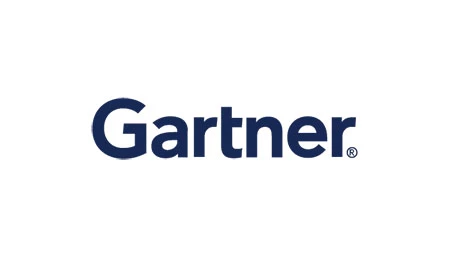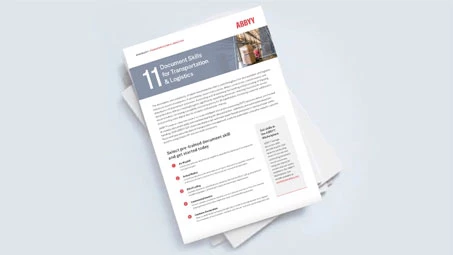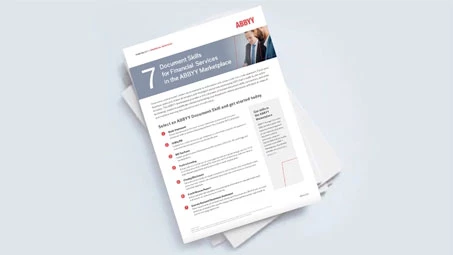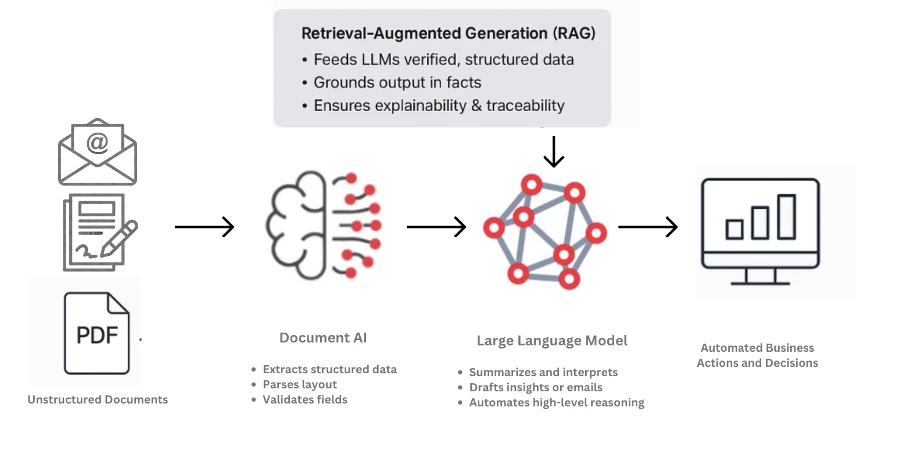
When IDP Meets LLMs, Smart Automation Gets Smarter
by Slavena Hristova, Director of Product Marketing
An AI-first mindset for solving business challenges is a welcome evolution—but it comes with a downside: the growing impulse to apply AI, especially generative AI, as a one-size-fits-all solution—even to problems that were already effectively solved with traditional methods.
A clear example is the use of GenAI and general-purpose large language model-based chatbots to process business documents.
While large language models (LLMs) have remarkable capabilities in understanding and generating text, they weren’t designed to retrieve precise facts or ensure consistency at scale. Their strength lies in generation, not extraction. When businesses rely on them for tasks like parsing invoices or validating compliance fields, the outcomes can be unpredictable—and in many cases, less reliable than existing approaches.
But that doesn’t mean LLMs have no place in document automation. On the contrary, their ability to reason, summarize, and interpret nuance opens up new opportunities to extend automation into areas that once required human oversight. When paired with purpose-built intelligent document processing (IDP), LLMs unlock powerful synergies—bringing both structure and intelligence to workflows that demand accuracy and insight.
To harness this potential, it’s essential to match each tool to the right task—and combine them in a way that amplifies their respective strengths.
Better together: When Document AI handles the facts, and LLMs handle the thinking
Large language models (LLMs) can do truly remarkable things, but anyone who’s used ChatGPT knows general-purpose LLMs can hallucinate, misinterpret context, or miss vital details entirely. Yet in business, reliability and precision are a must. That’s why LLMs are most effective only after information has been structured and validated, typically by Document AI.

In fact, Document AI and LLMs solve very different problems. Document AI parses layout, understands context, and retrieves facts that can be explained, audited, and scaled. By doing this work first, Document AI ensures that LLMs don’t rely on assumptions or incomplete data as they interpret and reason over text.
When used together, the strengths of one compensate for the limitations of the other. A purpose-built, pre-trained Document AI model can reliably extract data from invoices, contracts, or insurance claims. That structured data can then be passed to an LLM to interpret or act on it. The combination gives you both task and decision automation that you can trust.
How AI document processing tools use RAG to make LLMs more reliable
One very powerful way to combine Document AI and LLMs is with retrieval-augmented generation (RAG). With this method, LLMs generate responses based on validated, structured data produced by Document AI instead of relying solely on training data. This approach:
- Reduces hallucinations by grounding LLM outputs in verified data
- Ensures every answer can be traced back to a source for auditability
- Lets users see not just what the AI concluded but why
In essence, Document AI acts as a powerful lens that focuses and clarifies raw document data before it gets to an LLM.
When IDP meets LLMs: Proven results across industries
Already, businesses are combining Document AI with LLMs for a multiplier effect. One retail company, for example, used a combination of IDP and LLMs to process more than 30,000 lease agreements to meet new accounting standards. Data extraction accuracy jumped from 60% to 82%, and manual review time went down by the equivalent of 20 full-time employees.
Across industries, companies are seeing similar gains:
- Insurance: Automatically extracting structured claim data with Document AI, then using LLMs to generate claim summaries or customer responses.
- Healthcare: Parsing patient intake forms with IDP, then summarizing treatment histories for care teams with LLMs.
- Legal: Converting contracts into structured fields using IDP, with LLMs helping to flag risks and interpret clauses.
- Finance: Digitizing loan documents with IDP, then using LLMs to build client risk profiles or support compliance reviews.
Designing accurate and scalable document workflows with AI
The future of AI document automation requires integrating Document AI and LLMs intelligently. To get the most out of this combination, organizations should keep a few key principles in mind:
- Start with accuracy:
Begin with a trustworthy data layer, using Document AI to reliably extract facts before letting LLMs analyze or summarize them. - Design for consistency:
Don’t feed raw, unstructured documents to LLMs. Use proven RAG-based designs to make sure outputs are consistent and traceable. - Measure and optimize:
Use process analytics to track performance and detect bottlenecks for continuous improvement. - Plan for the future: Choose systems that combine the precision of structured data extraction with the flexibility of generative AI to prepare for future growth.
- Build on solid foundations:
Achieving true enterprise-grade automation requires more than language models. It demands robust infrastructure—including human-in-the-loop validation, exception handling, compliance controls, and continuous model uptraining. These capabilities form the foundation for scalable, trustworthy, and production-ready document workflows.
Speeding up workflows with LLMs doesn’t help if errors lead to rework and lost trust. The benefits of LLMs are only real when used correctly by adding reliable, structured inputs from Document AI. It’s this combination that turns automation into a competitive advantage and sets the foundation for what’s next.






